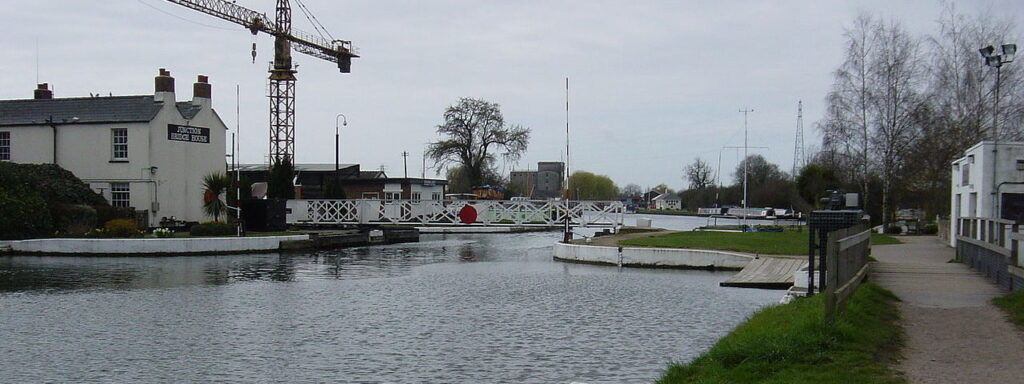This extract tells the story of James Herbert, son of an agricultural labourer, who followed many local young men in choosing a life afloat rather than staying ashore. The Severn Vale shipping community of sailing vessel owners and crews was based around the villages of Frampton, Saul and Arlingham in the 19th and early 20th centuries near the junction of the Gloucester & Sharpness Canal with the Stroudwater Canal at the head of the River Severn.
Early days
After leaving school, James Herbert joined the crew of one of the numerous small sailing vessels then trading around the Severn Estuary and Bristol Channel. He evidently made a good impression, as in 1872 (at the age of only 22) he became master of the barge ‘Ready Penny’, owned by Framilode coal merchant Richard Williams. He soon moved on to the larger ‘Nelly’ and then the ‘Maria’, both also owned by Richard Williams. These two barges regularly carried about 60 tons of Forest of Dean coal from Lydney to wharves along the Stroudwater and Thames & Severn Canals.
Coal to Stroud gasworks
In 1876, James Herbert took on a new role as master of the barge ‘Reliance’, owned by the Stroud Gas Light & Coke Co. For the next 20 years he averaged 40 trips a year to Newport, South Wales, to collect 65 to 70 tons of coal and bring it back to the gasworks. During this time, he lived at Framilode and then Whitminster, and he and his family were also involved in farming. James Herbert evidently prospered with his busy life, and in 1891 he was able to purchase his first vessel. The barge ‘John’ of 72 tons register, with successive local men as master, traded across the Bristol Channel, sailing between Newport, Bristol, Cardiff and Weston super Mare. Two years later James purchased the barge ‘Volunteer’, and with his eldest son Benjamin as master, this carried Forest coal from the railway tip at Sharpness to Stroud gasworks. Three years later ‘Volunteer’ was replaced by the barge ‘Wherry Packet’, which continued the same traffic. During this period, James’s younger brother Charles was also afloat, as master of barges owned by the Field family carrying coal from Bullo Pill to wharves along the Stroudwater Canal.
Owner/Master
After 20 years of routine shuttle between Newport and Stroud gasworks, in 1897 James Herbert arranged for Benjamin to replace him as master of the ‘Reliance’, leaving James himself free to become master of his own barge ‘John’. As befitting an owner/master, he also moved into the newly-built Kimberley House close to Fretherne Bridge. Unfortunately, his new life proved more exciting than had he would have wished. In the following March, the barge experienced heavy weather while sailing from Barry to Newport and foundered near the island of Flat Holm. The crew, who included James’s third son Arthur, had to take to the boat – they were later rescued by another vessel and landed at Weston. James Herbert replaced the ‘John’ with the smaller trow ‘Victory’, 37 tons register, and this he used to trade between Newport, Bristol, Chepstow and Bridgwater. On some of these trips, he was accompanied by one or more of his younger sons, Arthur, John and James jnr, until he handed over command to his son-in-law William Halling in 1910. By this time, he had also purchased vessels for other members of his family. His son Joseph became master of the Bridgwater registered ketch ‘Two Brothers’, his son William became master of the barge ‘Perseverance’, trading between Bristol, Lydney, Chepstow and Newport, and the ‘Wherry Packet’ was replaced by the ‘Endeavour’ taking coal from the Sharpness tip to Stroud gasworks. Meanwhile his eldest son Benjamin continued as master of the ‘Reliance’, still taking coal from Newport to Stroud gasworks.
Cadbury’s Factory
The Herbert family’s long association with Stroud gasworks was about to come to an end, however, as the opening of Cadbury’s factory near Fretherne Bridge in 1916 created another customer needing a regular supply of coal. Benjamin Herbert relinquished his command of the ‘Reliance’, the ‘Endeavour’ ceased carrying to Stroud gasworks and instead the family began supplying Cadbury’s with coal brought from the Sharpness tip. To help with this traffic, James Herbert bought the former Severn & Canal Carrying Co. barge ‘William’ in 1915, although four years later this was replaced by the smack ‘Industry’ which was fitted with a motor. Cadbury’s factory was partly built on land sold by James Herbert, and as his house became the home of the factory manager, he moved to Cambridge near Slimbridge and later to Oatfield between Frampton and Whitminster.

By the 1920s, the days of commercial sail were coming towards their end, but although over 70, James Herbert was determined to keep the old traditions going as long as possible. He bought the ‘Reliance’ after she ceased carrying coal to Stroud gasworks in 1920, and he bought the Bridgwater ketches ‘Marian’ and ‘Champion’ – the latter being an appropriate name for an owner who was a champion of coastal sailing vessels until he died in 1930. By this time, it was very difficult to keep such vessels trading profitably in competition with motor barges, and it was not long before most of James Herbert’s fleet were converted to towed barges or were broken up. Members of his family continued with their lives afloat, but they had to come to terms with the new mode of propulsion.
Published with permission: Hugh Conway-Jones

You must be logged in to post a comment.